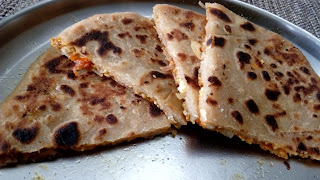Punjabi Style Gobi Masala
For the weekend lunch, we decided to have jeera rice with some gravy. I had stocked cauliflower in my fridge, so made this gobi masala. It come out really well. The taste still lingers in my tongue.
I had often tasted this gobi masala at north Indian restaurants, but after much hesitation i tried the recipe. It is so simple and easy, only a few ingredients are needed.
Cuisine: Punjabi
Preparation Time: 10 minutes
Cooking Time: 20 minutes
Yields:serves 4 to 5 persons
Ingredients:
Cauliflower: 1 no of medium size
Onion: 2 nos
Green chilli: 2 nos
Tomato: 1 no
Chilli powder: 1 and 1/2 teaspoons
Coriander powder: 3/4 teaspoon
Garam masala: 1 teaspoon
Turmeric powder: 1/2 teaspoon
Ginger garlic paste: 2 tea spoons
Salt to taste
Shahjeera: 1 teaspoon
Water as needed
Oil: 3 tea spoons
Kasuri methi: 1 teaspoon
Coriander leaves: 1 teaspoon finely chopped
Cashews: 8 to 10 pods
Cumin or Jeera powder: 1/2 teaspoon
Method:
1. Cut the cauliflowers into florets and put it in hot water with turmeric powder and a pinch of salt.
2. Finely chop one onion, slit the green chillis, chop coriander leaves and keep it ready.
3. Soak cashews in hot water. In the meantime, make a fine paste of the remaining onions and tomatoes. Keep it aside.
4. Place a pan on the stove over high flame, add 2 tea spoons of oil, when the oil is hot, add shahjeera, slit green chillies. Fry it for a minute, add ginger garlic paste and saute till the raw smell of garlic goes off.
5. Add the chopped onions and saute till it becomes translucent.
6. Now drain the water and add in the cauliflower florets. Mix it well.
7. Add the onion tomato paste and saute it for few minutes.
8. Add chillipowder, coriander powder, garam masala and salt to taste. Mix it well.
9. Add 1 cup of water till it immerses the florets. Close the pan with a lid and let it cook.
10. Make a fine paste of the cashews. Keep it aside.
11. When the gravy thickness, add the cashew paste and cook for 5 to 7 minutes till the raw smell of cashews goes off.
12. Add jeera powder and crush kasuri methi in your palms and add it to the gravy. Let it simmer for few more minutes.
13. The oil may appear on the top of the gravy, put off the flame. Add coriander leaves and transfer it to serving bowl.
14. The gravy goes well with jeera rice, pulao, roti and naan.
Note:
1. The proportion for ginger garlic paste is 1 and 1/2 inch piece of ginger and 7 to 8 pods of garlic.



































